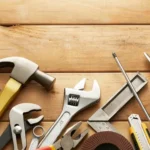Woodworking is a timeless craft that requires precision, patience, and the right set of tools.
Whether you are a beginner or a seasoned woodworker, selecting the right tools can make a significant difference in the quality and efficiency of your projects.
This guide will help you understand how to choose the best woodworking tools by considering key factors such as purpose, material compatibility, ergonomics, and budget.
Additionally, we will explore advanced tools, maintenance tips, and essential safety practices to ensure you get the best out of your woodworking experience.
Understanding Your Woodworking Needs
Before investing in woodworking tools, you should define the nature of your projects. Here are some key considerations:
| Type of Project | Recommended Tools |
|---|---|
| Basic DIY furniture | Hand saw, chisel set, power drill |
| Cabinet making | Table saw, router, clamps |
| Wood carving | Carving knives, gouges, mallet |
| Outdoor projects | Circular saw, jigsaw, weather-resistant clamps |
| Home renovations | Nail gun, miter saw, drill press |
| Fine woodworking | Scroll saw, precision chisels, carving tools |
By understanding your project requirements, you can focus on tools that will deliver the best results and make your woodworking journey more efficient and enjoyable.
ALSO READ: How to Choose the Right Console for Your Gaming Style?
Types of Essential Woodworking Tools
Hand Tools
Hand tools offer precision and control, making them ideal for detailed work. Some essential hand tools include:
- Chisels: Used for carving and shaping wood.
- Hand saws: Available in different types like rip saws, crosscut saws, and dovetail saws.
- Planes: Used to smooth and level wooden surfaces.
- Mallets & Hammers: Helps in assembling and disassembling wooden parts.
- Measuring & Marking Tools: Such as tape measures, combination squares, and marking gauges.
- Clamps: Essential for holding wood securely while working on joints and assembly.
Power Tools
Power tools help in efficient cutting, shaping, and assembling. Some must-have power tools include:
- Table saw: Ideal for making precise cuts.
- Circular saw: Perfect for cutting large wooden sheets.
- Router: Essential for making decorative edges and joinery.
- Drill & Impact Driver: Used for making holes and fastening.
- Orbital Sander: Helps in achieving a smooth finish.
- Jigsaw: Perfect for intricate and curved cuts.
- Miter Saw: Used for making precise crosscuts and angled cuts.
Factors to Consider When Selecting Tools
Choosing the best woodworking tools involves assessing various factors:
Quality & Durability
Invest in high-quality tools made from durable materials like carbon steel and tungsten carbide.
Cheaper alternatives may not last long and can affect precision. Researching brand reputation and user reviews can help in making the right investment.
Ergonomics & Comfort
Tools with ergonomic handles reduce hand fatigue and improve efficiency. Check for rubberized grips and balanced weight distribution.
A well-balanced tool can significantly improve control and precision in woodworking tasks.
Power Source: Corded vs. Cordless
| Feature | Corded Tools | Cordless Tools |
|---|---|---|
| Power | Higher power | Moderate power |
| Mobility | Limited by cable | Highly portable |
| Best For | Heavy-duty tasks | Quick and mobile tasks |
| Battery Dependency | Not required | Requires battery recharging |
Safety Features
Look for tools with built-in safety features such as blade guards, auto shut-off, and dust collection systems.
Investing in tools with anti-kickback mechanisms and ergonomic designs can further reduce risks while working.
Budget & Brand Reputation
Balancing budget with quality is crucial. Trusted brands like DeWalt, Bosch, Makita, Festool, and Milwaukee offer high-performance woodworking tools.
Conduct research and compare prices before purchasing to ensure you get the best value for your money.
ALSO READ: How to Collaborate with Other Bloggers to Grow Your Audience?
Specialty Tools for Advanced Woodworkers
Once you master the basics, consider adding specialty tools to enhance your capabilities:
- Lathe: Used for woodturning projects.
- Band Saw: Ideal for intricate cuts and curves.
- Dovetail Jig: Helps create strong and precise joinery.
- Biscuit Joiner: Used for making hidden joints.
- Scroll Saw: Perfect for detailed and decorative cuts.
- Drum Sander: Useful for smoothing large wooden surfaces evenly.
Maintenance & Care of Woodworking Tools
Proper maintenance extends the lifespan of your tools and ensures accuracy:
| Maintenance Task | Recommended Frequency |
|---|---|
| Cleaning | After each use |
| Sharpening blades | Monthly or as needed |
| Lubrication | Every few months |
| Inspection for damage | Before each project |
| Battery check (for cordless tools) | Weekly |
| Storage in a dry environment | Always |
Store tools in a dry and organized space to prevent rust and damage. Consider using protective cases or tool racks to keep them secure and accessible.
Safety Tips for Woodworking
Safety is paramount in woodworking. Following these precautions can prevent accidents:
- Wear Protective Gear: Use safety glasses, gloves, and a dust mask to protect against flying debris and dust inhalation.
- Use a Push Stick: When working with table saws, always use a push stick to keep your hands at a safe distance from the blade.
- Keep Blades Sharp: Dull blades can lead to rough cuts and increase the risk of kickback.
- Maintain a Clean Workspace: Clutter can be hazardous; keep your work area tidy.
- Read the Manual: Familiarize yourself with the operating instructions of each tool before use.
- Use Clamps: Secure wood with clamps instead of holding it by hand when cutting or drilling.
Conclusion
Selecting the best woodworking tools requires careful consideration of your project needs, tool quality, safety, and budget.
By investing in the right tools and maintaining them properly, you can ensure long-term efficiency and high-quality craftsmanship.
Whether you are a beginner or an expert, using the right tools will enhance your woodworking experience and help you achieve professional-grade results.
Additionally, prioritizing safety and proper maintenance will not only protect you from potential hazards but also improve the lifespan of your tools.
With the right approach, you can master the art of woodworking and create stunning, durable projects that stand the test of time.







